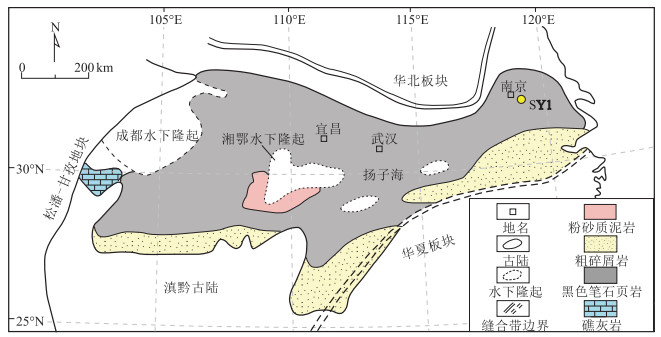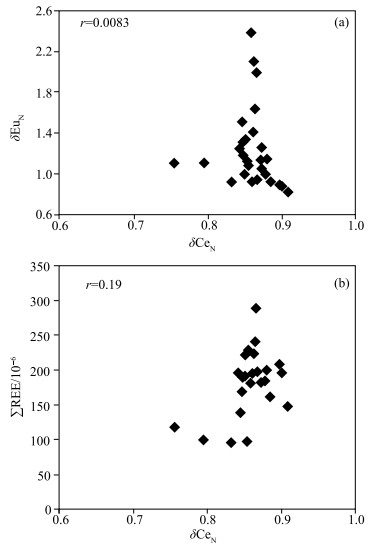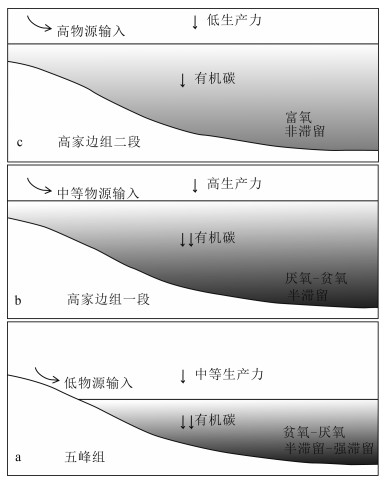Characteristics of REE and sedimentary environment of mud shale in Wufeng Formation-Gaojiabian Formation in Jurong area, Jiangsu Province
-
摘要:
为深入研究江苏句容地区五峰组-高家边组泥页岩的沉积环境、构造背景及物源属性, 指导区域页岩气勘探, 利用等离子体质谱技术对江苏句容地区SY1井五峰组-高家边组泥页岩的稀土元素地球化学特征和沉积环境进行研究。结果表明, 句容地区五峰组泥页岩稀土元素总量低于北美页岩, 高家边组泥页岩稀土元素总量高于北美页岩, 且五峰组-高家边组泥页岩都具有轻稀土元素富集的特征, 轻、重稀土元素分馏程度较高, 分异程度显示从底至顶逐步升高的趋势。δCeN值为0.76~0.91, 平均值为0.86, 显示弱的负Ce异常; 五峰组泥页岩δEuN平均值为1.11, 高家边组一段和二段泥页岩δEuN平均值分别为1.71和1.11, 表明高家边组一段分异最明显, 变化范围较大, 五峰组物源特征较单一, 而高家边组母岩成分复杂, 具有混合特征。五峰组泥页岩的(La/Yb)s平均值为1.28, 高家边组一段泥页岩的(La/Yb)s平均值为1.38, 高家边组二段泥页岩的(La/Yb)s平均值为1.51, 反映出五峰组沉积速率小于高家边组, 且有机质丰度与(La/Yb)s值具有一定的负相关性。δEu、δCe、U/Th、V/Cr、Ni/Co等参数特征揭示, 五峰组-高家边组一段-高家边组二段沉积时期海水的还原性具有富氧-厌氧-富氧过渡的变化特征, 其中高家边组一段底部水体还原程度最高, 为厌氧环境。奥陶纪末期—志留纪早期还原性水体及相对滞留的沉积环境有利于有机质保存, 使句容地区五峰组-高家边组富有机质泥页岩的厚度达到30 m, 由此初步认为, 五峰组-高家边组一段泥页岩为优质页岩气储层。
Abstract:In order to explore the depositional and tectonic environment as well as provenance feature of the mud shale of Wufeng Formation-Gaojiabian Formation and guide regional shale gas exploration, the rare earth element composition (REE) of these rocks in Well SY1 from Jurong area was analyzed by Inductively Coupled-Mass Spectrometry (ICP-MS) in this study.The result shows that the total amount of rare earth elements of mud shale in Wufeng Formation is lower than that in North American shale while that in Gaojiabian Formation is reverse.Both Wufeng Formation and Gaojiabian Formation of mud shale are characterized by enrichment of the light rare earth elements and by commonly high fractionation which gradually increases from the bottom to the top. δCeN value is 0.76~0.91, with an average value of 0.86, showing a weak negative anomaly.The δEuN mean value of mud shale in Wufeng Formation is 1.11, while that of the first member and the second member of Gaojiabian Formation is 1.71 and 1.11, respectively, indicating that the first member of Gaojiabian Formation has the most obvious differentiation and a large range of variation.The ΣREE-La/Yb graphic shows that the provenance of mud shale in Wufeng Formation is relatively single, while the parent rocks of mud shale in Gaojiabian Formation have complex and mixed composition.The mean value of La/Yb indicates that the deposition rate of mud shale in Wufeng Formation is less than that of Gaojiabian Formation, and the abundance of organic matter is negatively correlated with the value of(La/Yb)s to a certain extent. δEu, δCe, U/Th, V/Cr, Ni/Co and other parameters suggest that the seawater reducibility were characterized by oxygen-enriched, anaerobic and oxygen-enriched transition from base to top.The reduced water and relatively euxinic sedimentary environment in the Late Ordovician and Early Silurian were favorable for the preservation of organic matter, which resulted in the organic-rich mud shales in the Wufeng Formation-Gaojiabian Formation in Jurong area reaching a thickness of about 30 meters.Accordingly, the shale of Wufeng Formation and the first member of Gaojiabian Formation in the Jurong area represent a high-quality shale gas reservoir.
-

-
图 6 SY1井五峰组-高家边组泥页岩ΣREE-La/Yb图解(底图据参考文献[38])
Figure 6.
表 1 SY1井五峰组-高家边组泥页岩稀土元素含量
Table 1. Contents of rare earth elements of mud shale in Wufeng Formation -Gaojiabian Formation in well SY1
10-6 样品号 La Ce Pr Nd Sm Eu Gd Tb Dy Ho Er Tm Yb Lu SY1-10 21.83 38.43 4.78 17.15 3.09 1.15 3.3 0.53 3.28 0.59 1.82 0.27 1.69 0.27 SY1-13 33.4 56.78 6.81 24.34 3.68 1.42 3.27 0.46 3.11 0.69 2.11 0.37 2.21 0.34 SY1-16 28.33 43.33 5.88 21.12 4.17 1.44 3.91 0.56 3.23 0.62 2 0.3 2.05 0.34 SY1-19 22.87 36.72 4.71 18.14 3.21 1.16 3.36 0.5 3.09 0.63 1.89 0.3 1.86 0.31 SY1-22 20.92 36.04 4.63 17.65 3.18 1.01 3.74 0.56 3.15 0.64 1.85 0.28 1.73 0.27 SY1-24 51.99 92.69 11.41 42.69 8.58 4.39 8.05 1.28 7.69 1.57 4.82 0.74 4.45 0.76 SY1-25 51.08 89.05 10.53 38.6 7.03 4.66 6.83 0.95 5.77 1.2 3.72 0.62 3.64 0.55 SY1-26 40.29 71.32 8.81 31.54 5.98 4.35 5.39 0.82 4.94 0.98 3.11 0.48 3.17 0.5 SY1-28 71.23 121.31 13.59 45.79 7.75 4.69 6.85 0.95 6.07 1.24 3.92 0.63 3.86 0.64 SY1-31 41.2 73.66 8.9 32.28 5.96 2.05 5.23 0.83 5.14 1.01 3.12 0.49 2.95 0.46 SY1-37 46.4 78.44 9.12 31.53 5.4 1.71 5.38 0.9 5.57 1.09 3.25 0.53 3.14 0.47 SY1-40 52.12 91.44 11.25 43.44 7 2.34 6.28 0.89 5.52 1.13 3.31 0.52 3.34 0.51 SY1-42 46.31 85.97 10.23 37.98 6.52 1.81 6.05 0.82 5.13 1.01 3.13 0.51 3.02 0.54 SY1-43 36 65.11 7.68 29.18 4.94 1.5 5.18 0.76 4.32 0.86 2.52 0.39 2.47 0.4 SY1-44 45.62 79.58 9.51 35.25 5.94 1.72 5.63 0.69 4.77 0.97 2.93 0.48 2.91 0.44 SY1-45 52.77 90.3 10.36 38.73 6.6 2.87 6.02 0.9 5.66 1.14 3.18 0.47 2.9 0.42 SY1-46 45.49 79.93 9.46 35.25 7.39 2.04 5.82 0.79 4.92 1.05 3.05 0.48 3 0.45 SY1-49 40.94 74.11 8.96 34.26 5.58 1.77 5.54 0.85 4.91 0.97 3.03 0.46 2.84 0.47 SY1-51 46.92 80.27 9.85 33.39 6.09 2.21 4.76 0.69 4.44 0.95 2.9 0.44 2.91 0.44 SY1-52 41.72 73.66 8.66 31.29 5.32 2.07 4.94 0.76 4.59 0.91 2.83 0.45 2.76 0.43 SY1-54 38.86 67.16 8.29 30.91 5.2 2.36 4.46 0.66 4.08 0.8 2.58 0.37 2.46 0.35 SY1-55 45.1 76.96 9.21 33.89 5.85 2.34 5.1 0.74 4.44 0.91 2.66 0.42 2.61 0.4 SY1-56 43.93 76.16 9.27 34.51 5.42 2.39 5.76 0.78 4.98 0.98 2.99 0.46 2.91 0.42 SY1-57 44.45 76.73 9.38 33.64 6.67 2.31 5.2 0.79 4.83 0.93 2.85 0.47 2.83 0.45 SY1-59 30.28 58.49 7.22 28.56 5.4 1.43 5.32 0.79 4.39 0.82 2.36 0.35 2.29 0.37 SY1-62 43.67 80.04 9.21 35.38 6.86 1.85 5.98 0.88 5.03 0.99 2.94 0.46 2.85 0.45 SY1-65 52.25 89.62 10.73 39.84 7.17 2.09 5.59 0.88 5.12 1.07 3.24 0.49 3.2 0.48 SY1-68 44.06 77.87 9.15 33.39 5.85 1.86 5.05 0.71 4.56 1.01 3.05 0.46 2.92 0.46 SY1-71 46.27 82.89 9.76 35.38 5.96 2.04 5 0.71 4.42 0.9 2.97 0.45 2.8 0.54 北美页岩[21] 32 73 7.9 33 5.7 1.24 5.2 0.85 5.8 1.04 3.4 0.5 3.1 0.48 球粒陨石[21] 0.3 0.8 0.12 0.6 0.19 0.07 0.26 0.05 0.32 0.07 0.21 0.03 0.21 0.03 表 2 SY1井五峰组-高家边组泥页岩稀土元素地球化学特征
Table 2. REE geochemical characteristics of mud shale in Wufeng Formation - Gaojiabian Formation in well SY1
样号 ΣREE/
10-6ΣLREE/
10-6ΣHREE/
10-6ΣLREE/
ΣHREE(La/Yb)N (La/Sm)N (Ce/Yb)N (La/Yb)s δCeN δEuN δCeS δEuS TOC/% SY1-10 98.18 86.43 11.75 7.36 9.04 4.47 5.97 1.25 0.85 1.13 0.83 1.58 2.08 SY1-13 138.99 126.43 12.56 10.07 10.58 5.75 6.74 1.46 0.84 1.27 0.81 1.80 1.17 SY1-16 117.28 104.27 13.01 8.01 9.67 4.30 5.55 1.34 0.76 1.11 0.85 1.57 2.47 SY1-19 98.75 86.81 11.94 7.27 8.61 4.51 5.18 1.19 0.79 1.11 0.82 1.55 2.47 SY1-22 95.65 83.43 12.22 6.83 8.46 4.17 5.47 1.17 0.83 0.93 0.77 1.28 2.47 SY1-24 241.11 211.75 29.36 7.21 8.18 3.84 5.47 1.13 0.86 1.65 0.87 2.32 1.86 SY1-25 224.23 200.95 23.28 8.63 9.82 4.60 6.42 1.36 0.86 2.10 0.84 2.95 2.85 SY1-26 181.68 162.29 19.39 8.37 8.90 4.27 5.91 1.23 0.86 2.38 0.85 3.36 — SY1-28 288.52 264.36 24.16 10.94 12.92 5.82 8.25 1.79 0.86 2.00 0.82 2.83 2.71 SY1-31 183.28 164.05 19.23 8.53 9.78 4.38 6.55 1.35 0.87 1.14 0.84 1.61 1.83 SY1-37 192.93 172.6 20.33 8.49 10.34 5.44 6.56 1.43 0.85 0.99 0.82 1.39 1.10 SY1-40 229.09 207.59 21.5 9.66 10.92 4.72 7.19 1.51 0.85 1.10 0.86 1.55 0.16 SY1-42 209.03 188.82 20.21 9.34 10.73 4.50 7.47 1.49 0.90 0.90 0.82 1.27 0.33 SY1-43 161.31 144.41 16.9 8.54 10.20 4.62 6.92 1.41 0.88 0.93 0.80 1.30 0.13 SY1-44 196.44 177.62 18.82 9.44 10.97 4.86 7.18 1.52 0.86 0.93 0.83 1.31 0.39 SY1-45 222.32 201.63 20.69 9.75 12.74 5.06 8.17 1.76 0.86 1.42 0.82 2.00 0.16 SY1-46 199.12 179.56 19.56 9.18 10.61 3.90 6.99 1.47 0.87 0.95 0.83 1.36 0.58 SY1-49 184.69 165.62 19.07 8.68 10.09 4.65 6.85 1.40 0.88 1.00 0.84 1.40 0.24 SY1-51 196.26 178.73 17.53 10.20 11.29 4.88 7.24 1.56 0.84 1.25 0.84 1.80 0.99 SY1-52 180.39 162.72 17.67 9.21 10.58 4.97 7.01 1.46 0.87 1.26 0.81 1.77 0.74 SY1-54 168.54 152.78 15.76 9.69 11.06 4.73 7.17 1.53 0.85 1.51 0.86 2.15 1.80 SY1-55 190.63 173.35 17.28 10.03 12.10 4.88 7.74 1.67 0.85 1.33 0.82 1.88 1.70 SY1-56 190.96 171.68 19.28 8.90 10.57 5.13 6.87 1.46 0.85 1.35 0.82 1.87 1.89 SY1-57 191.53 173.18 18.35 9.44 10.99 4.22 7.12 1.52 0.85 1.20 0.84 1.72 1.60 SY1-59 148.07 131.38 16.69 7.87 9.26 3.55 6.70 1.28 0.91 0.84 0.82 1.17 0.08 SY1-62 196.59 177.01 19.58 9.04 10.73 4.03 7.37 1.48 0.90 0.89 0.73 1.27 0.13 SY1-65 221.77 201.7 20.07 10.05 11.43 4.62 7.35 1.58 0.85 1.01 0.84 1.44 0.28 SY1-68 190.4 172.18 18.22 9.45 10.56 4.77 7.00 1.46 0.87 1.06 0.83 1.50 0.36 SY1-71 200.09 182.3 17.79 10.25 11.57 4.92 7.77 1.60 0.88 1.15 0.84 1.64 0.46 注: 稀土元素总量ΣREE =La+Ce+Pr+Nd+Sm+Eu+Gd+Tb+Dy+Ho+Er+Tm+Yb+Lu; 轻稀土元素含量ΣLREE = La+Ce+Pr+Nd+Sm+Eu; 重稀土元素含量ΣHREE = Gd+Tb+Dy+Ho+Er+Tm+Yb+Lu; (La/Sm)N、(La/Yb)N和(Gd/Yb)N为经球粒陨石标准化的比值;δCeN =2CeN/(La+ Pr)N,δEuN =2EuN/(Sm+ Gd)N,此处的N代表经球粒陨石标准化的比值;δEuS =2EuS/(Sm+ Gd)S,此处EuS、SmS、GdS、CeS、LaS和NdS为经北美页岩标准化后的值 -
[1] Hatch J R, Leventhal J S. Relationship between inferred redox potential of the depositional environment and geochemistry of the Upper Pennsylvanian(Missourian)Stark Shale Member of the Dennis Limestone, Wabaunsee County, Kansas, U.S. A[J]. Chemical Geology, 1992, 99(1/3): 65-82. https://www.sciencedirect.com/science/article/pii/000925419290031Y
[2] 朱志军, 陈洪德, 林良彪, 等. 川东南—湘西地区志留系小河坝组砂岩微量元素地球化学特征及意义[J]. 地质科技情报, 2010, 29(2): 24-30. https://www.cnki.com.cn/Article/CJFDTOTAL-DZKQ201002007.htm
[3] 万友利, 王剑, 万方, 等. 羌塘盆地南部古油藏带布曲组碳酸盐岩稀土元素特征及意义[J]. 石油实验地质, 2017, 39(5): 655-665. https://www.cnki.com.cn/Article/CJFDTOTAL-SYSD201705011.htm
[4] 郭春涛, 李德武, 陈树民. 塔里木盆地古城地区上寒武统白云岩稀土元素地球化学特征及成因模式[J]. 石油实验地质, 2017, 39(5): 666-674. https://www.cnki.com.cn/Article/CJFDTOTAL-SYSD201705012.htm
[5] 田景春, 张翔. 沉积地球化学[M]. 北京: 地质出版社, 2016.
[6] 王淑芳, 董大忠, 王玉满, 等. 四川盆地南部志留系龙马溪组富有机质页岩沉积环境的元素地球化学判别指标[J]. 海相油气地质, 2014, 19(3): 27-34. https://www.cnki.com.cn/Article/CJFDTOTAL-HXYQ201403005.htm
[7] 梁世友, 陈迎宾, 赵国伟, 等. 四川盆地川西坳陷雷口坡组四段稀土元素地球化学特征及意义[J]. 石油实验地质, 2017, 39(1): 94-98. https://www.cnki.com.cn/Article/CJFDTOTAL-SYSD201701014.htm
[8] 赵立鹏, 王冉, 钟方军, 等. 赣东北重点泥页岩层系地球化学特征分析[J]. 特种油气藏, 2017, 24(1): 64-69. https://www.cnki.com.cn/Article/CJFDTOTAL-TZCZ201701013.htm
[9] 何德军, 陈洪德, 钱利军. 新场地区须二段泥岩稀土元素地球化学特征及意义[J]. 断块油气田, 2013, 20(2): 157-161. https://www.cnki.com.cn/Article/CJFDTOTAL-DKYT201302008.htm
[10] 李双建, 肖开华, 沃玉进, 等. 湘西、黔北地区志留系稀土元素地球化学特征及其地质意义[J]. 现代地质, 2008, 22(2): 133-140. https://www.cnki.com.cn/Article/CJFDTOTAL-XDDZ200802014.htm
[11] 张廷山, 陈晓慧, 兰光志, 等. 川东南地区志留纪稀土元素分布及其地质意义[J]. 西南石油大学学报(自然科学版), 1998, 20(3): 26-30. https://www.cnki.com.cn/Article/CJFDTOTAL-XNSY803.007.htm
[12] 徐文礼, 郑荣才, 颜雪, 等. 下扬子地区早古生代黑色岩系地球化学特征及其地质意义[J]. 吉林大学学报(地球科学版), 2014, 44(4): 1108-1122. https://www.cnki.com.cn/Article/CJFDTOTAL-CCDZ201404006.htm
[13] 刘宝珺, 许效松, 潘杏南, 等. 中国南方古大陆沉积地壳演化与成矿[M]. 北京: 科学出版社, 1993.
[14] 刘宝珺, 许效松. 中国南方岩相古地理图集: 震旦纪—三叠纪[M]. 北京: 科学出版社, 1994.
[15] 万方, 许效松. 川滇黔桂地区志留纪构造-岩相古地理[J]. 古地理学报, 2003, 5(2): 180-186. https://www.cnki.com.cn/Article/CJFDTOTAL-GDLX200302005.htm
[16] 吴俊, 徐锦龙. 江南断裂带周边地区志留系层序地层特征及页岩气勘探前景[J]. 华东地质, 2020, 41(2): 184-194. https://www.cnki.com.cn/Article/CJFDTOTAL-HSDZ202002012.htm
[17] 殷启春, 方朝刚, 郑红军, 等. 下扬子地区奥陶纪页岩气地质条件及远景区优选[J]. 华东地质, 2020, 41(1): 70-78. https://www.cnki.com.cn/Article/CJFDTOTAL-HSDZ202001011.htm
[18] 陈清, 樊隽轩, 张琳娜, 等. 下扬子区奥陶纪晚期古地理演变及华南"台-坡-盆"格局的打破[J]. 中国科学: 地球科学, 2018, 48(6): 767-777. https://www.cnki.com.cn/Article/CJFDTOTAL-JDXK201806009.htm
[19] 李建青, 章诚诚, 黄正清, 等. 下扬子复杂构造区超高压含气层的发现及油气富集关键要素[J]. 地质通报, 2021, 40(4): 577-585. http://dzhtb.cgs.cn/gbc/ch/reader/view_abstract.aspx?file_no=20210414&flag=1
[20] 赵青芳, 王建强, 陈建文, 等. 下扬子区海相古生界高成熟烃源岩评价指标的优选[J]. 地质通报, 2021, 40(2/3): 330-340. http://dzhtb.cgs.cn/gbc/ch/reader/view_abstract.aspx?file_no=2021020314&flag=1
[21] Cao J, Wu M, Chen Y, et al. Trace and rare earth element geochemistry of Jurassic mudstones in the northern Qaidam Basin, northwest China[J]. Geochemistry, 2012, 72(3): 245-252. https://www.sciencedirect.com/science/article/pii/S0009281912000025
[22] Haskin L A, Wildeman T R, Freyfa, et al. Rare earths in sediments[J]. Journal of Geophysical Research, 1966, 71(24): 6091-6105.
[23] 吴石头, 王亚平, 孙德忠, 等. 电感耦合等离子体发射光谱法测定稀土矿石中15种稀土元素——四种前处理方法的比较[J]. 岩矿测试, 2014, 33(1): 12-19. https://www.cnki.com.cn/Article/CJFDTOTAL-YKCS201401004.htm
[24] 赖才根, 金若谷, 林宝玉, 等. 下扬子地区奥陶纪的生物相、沉积相机古地理特征[M]. 北京: 地质出版社, 1993.
[25] 吴浩若. 下扬子区加里东期构造古地理问题[J]. 古地理学报, 2005, 7(2): 243-248. https://www.cnki.com.cn/Article/CJFDTOTAL-GDLX200502010.htm
[26] 方朝刚, 黄正清, 滕龙, 等. 下扬子地区晚奥陶世凯迪期—早志留世鲁丹期岩相古地理及其油气地质意义[J]. 中国地质, 2020, 47(1): 144-160. https://www.cnki.com.cn/Article/CJFDTOTAL-DIZI202001013.htm
[27] 孟楚洁, 胡文瑄, 贾东, 等. 宁镇地区上奥陶统五峰组—下志留统高家边组底部黑色岩系地球化学特征与沉积环境分析[J]. 地学前缘, 2017, 24(6): 304-315. https://www.cnki.com.cn/Article/CJFDTOTAL-DXQY201706026.htm
[28] 吴跃东, 钟华明. 皖南地区奥陶系层序地层学分析[J]. 现代地质, 2002, 16(1): 45-52. https://www.cnki.com.cn/Article/CJFDTOTAL-XDDZ200201007.htm
[29] 朱洪发, 张渝昌, 秦德余, 等. 论浙皖赣闽地区早古生代盆地沉积特征及其构造环境[J]. 石油实验地质, 1990, 12(2): 121-134. https://www.cnki.com.cn/Article/CJFDTOTAL-SYSD199002002.htm
[30] 毛瑞勇, 张杰, 冷济高, 等. 岑巩页岩气区块牛蹄塘组黑色页岩稀土元素地球化学特征及沉积环境分析[J]. 矿物岩石, 2016, 36(4): 66-73. https://www.cnki.com.cn/Article/CJFDTOTAL-KWYS201604009.htm
[31] 张春明, 姜在兴, 郭英海, 等. 川东南—黔北地区龙马溪组地球化学特征与古环境恢复[J]. 地质科技情报, 2013, 32(2): 124-130. https://www.cnki.com.cn/Article/CJFDTOTAL-DZKQ201302017.htm
[32] 秦燕, 王登红, 梁婷, 等. 广西大厂锡多金属矿区深部碳酸盐岩的稀土元素特征及其地质意义[J]. 岩矿测试, 2014, 33(2): 296-302. https://www.cnki.com.cn/Article/CJFDTOTAL-YKCS201402025.htm
[33] 王中刚, 于学元, 赵振华. 稀土元素地球化学[M]. 北京: 科学出版社, 1989.
[34] 刘锐娥, 卫孝峰, 王亚丽, 等. 泥质岩稀土元素地球化学特征在物源分析中的意义: 以鄂尔多斯盆地上古生界为例[J]. 天然气地球科学, 2005, 16(6): 788-791. https://www.cnki.com.cn/Article/CJFDTOTAL-TDKX200506022.htm
[35] Shields G, Stille P. Diagenetic constraints on the use of cerium anomalies as palaeoseawater redox proxies: an isotopic and REE study of Cambrian phosphorites[J]. Chemical Geology, 2001, 175(1/2): 29-48.
[36] 常华进, 储雪蕾, 冯连君, 等. 氧化还原敏感微量元素对古海洋沉积环境的指示意[J]. 地质论评, 2009, 55(1): 91-99. doi: 10.3321/j.issn:0371-5736.2009.01.011
[37] Jones B, Manning D A C. Comparison of geochemical indices used for the interpretation of depositional environments in ancient mudstones[J]. Chemical Geology, 1994, 111(1/2/3/4): 112-129.
[38] 王欣欣, 郑荣才, 闫国强, 等. 基于稀土元素地球化学特征的泥岩沉积环境及物源分析——以鄂尔多斯盆地陇东地区长9油层组泥岩为例[J]. 天然气地球科学, 2014, 25(9): 1387-1394. https://www.cnki.com.cn/Article/CJFDTOTAL-TDKX201409011.htm
[39] Yang S, Hu W, Yao S, et al. Constraints on the accumulation of organic matter in Upper Ordovician-lower Silurian black shales from the Lower Yangtze region, South China[J]. Marine and Petroleum Geology, 2020, 120: 104544.
[40] 黄正清, 方朝刚, 李建青, 等. 宁镇地区五峰组-高家边组页岩U-Mo协变模式与古海盆水体滞留程度[J]. 成都理工大学学报: 自然科学版, 2020, 47(4): 443-450. https://www.cnki.com.cn/Article/CJFDTOTAL-CDLG202004006.htm
[41] Shen J, Lei Y, Algeo T J, et al. Volcanic Effects on Microplankton during the Permian-Triassic Transition(Shangsi and Xinmin, South China)volcanism and Permian-Triassic microplankton[J]. Palaios, 2013, 28(8): 552-567.
-




 下载:
下载:





